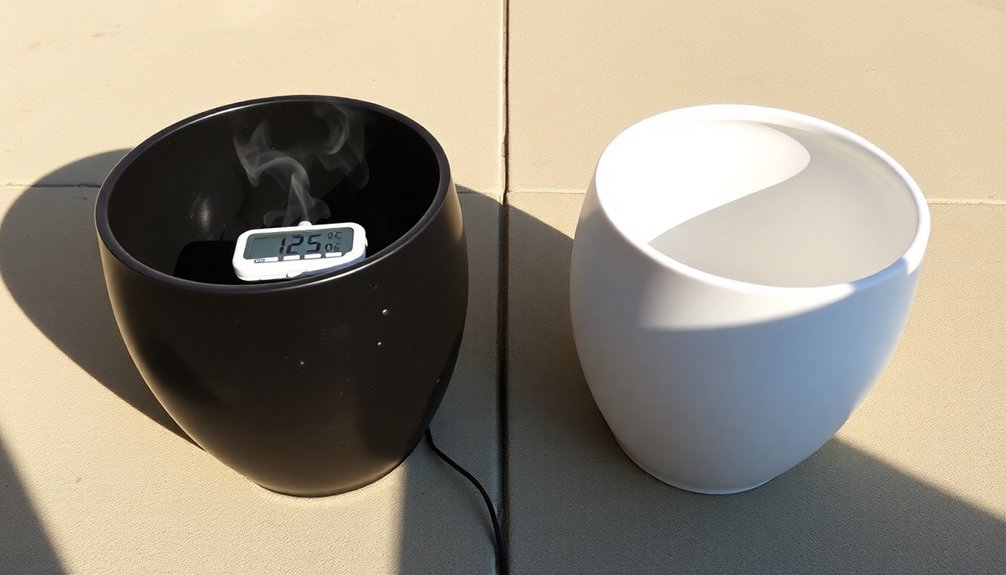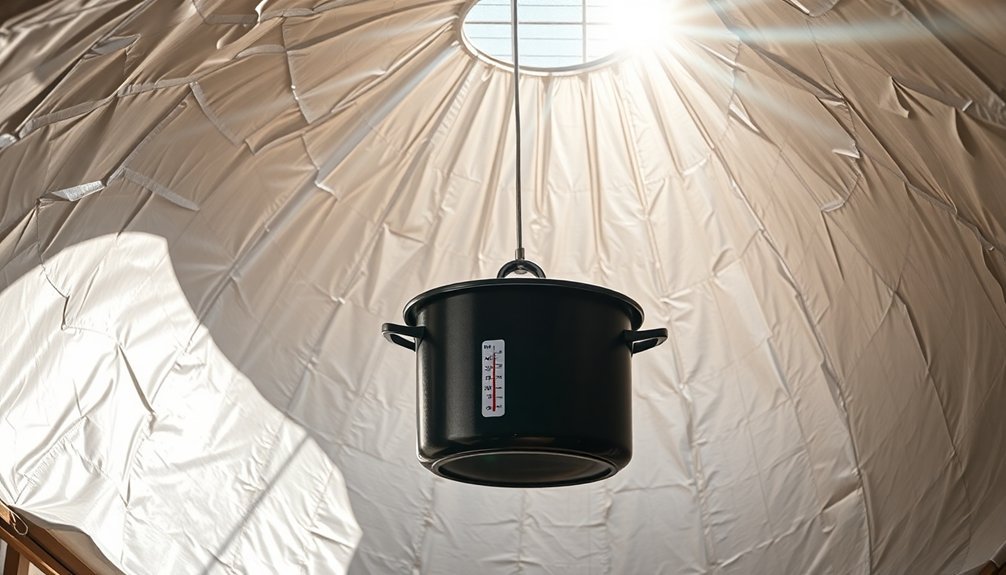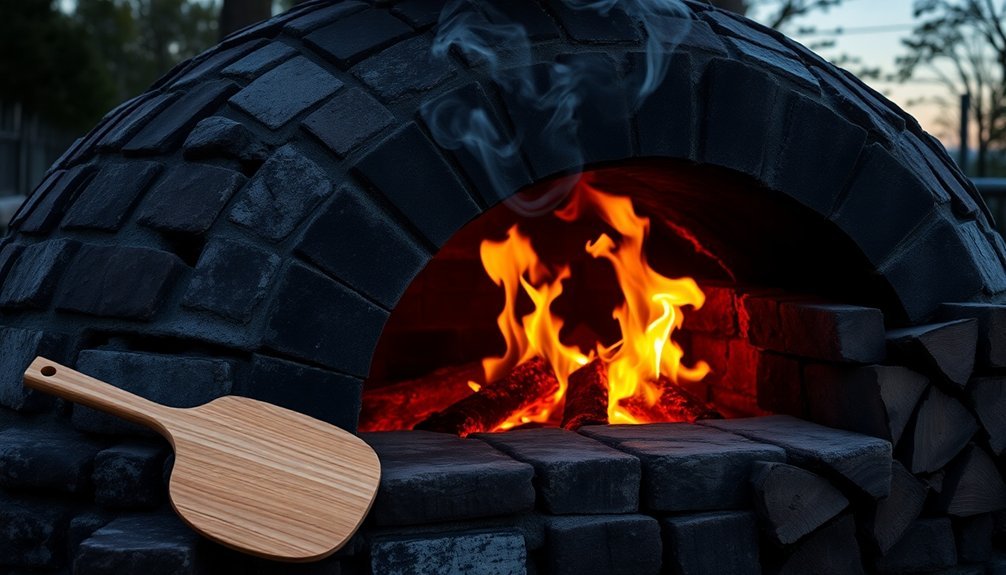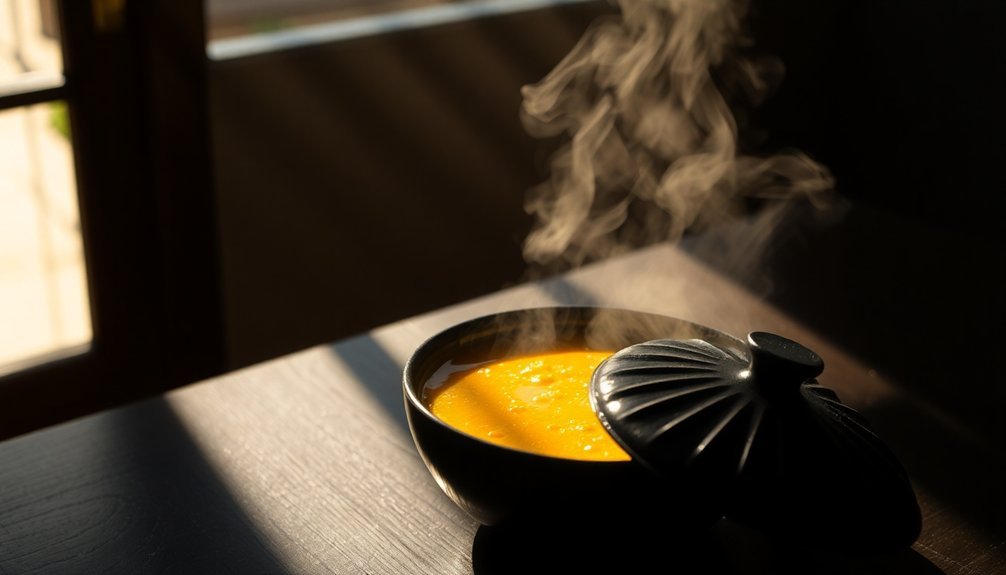Dark pots hold heat longer outside because they absorb up to 90% of solar radiation, compared to light-colored pots that only capture 25-40%. Your dark pots act like perfect black bodies, efficiently converting about 85% of captured solar energy into heat energy. They'll maintain this warmth through their higher thermal mass, which allows them to store and release heat more slowly than lighter containers. Dark materials' superior emissivity means they'll heat up faster and retain warmth longer, especially when placed on heat-conducting surfaces like concrete. Understanding these thermal properties can help you maximize your pots' heat retention capabilities.
The Physics Behind Dark Pots

While many home cooks understand that dark pots heat differently than light ones, the physics behind this phenomenon is fascinating. Your dark pots work like efficient heat magnets due to their surface properties and color. They're better at absorbing infrared radiation, which means they'll heat up more quickly than their lighter counterparts.
When you're cooking with dark pots, you'll notice they don't just absorb heat well – they're also superior at emitting it. This process follows the principle that heat flows from hot to cooler objects. This is due to their higher emissivity, a measure of how effectively a surface can transfer heat through radiation.
The matte or rough texture of dark surfaces enhances this property even further. In contrast, if you've used light, shiny pots, you'll see they reflect more heat away, making them less efficient at heat absorption and retention.
Understanding Solar Heat Absorption
You'll notice that dark surfaces absorb considerably more solar radiation, with black and dark blue surfaces capturing up to 90% of the sun's energy compared to just 25-40% for white surfaces.
When you're looking at heat retention in pots, this means darker vessels will naturally accumulate more thermal energy throughout the day, making them more efficient at maintaining higher temperatures. Modern research has shown that materials utilizing nanocavities for absorption can enhance this heat-trapping effect even further.
The color's impact on temperature isn't just immediate – darker pots continue to absorb and retain heat more effectively over time, which explains why they stay warmer longer than their lighter counterparts.
Dark Surface Radiation Properties
Dark surfaces act as powerful solar energy collectors due to their unique radiation properties. When sunlight hits a dark pot, most photons are absorbed rather than reflected, converting light energy directly into heat. This absorbed energy increases the pot's temperature and creates an efficient heat retention system.
The radiation properties of dark surfaces follow three key principles:
- Higher absorption rates: Dark surfaces capture more visible light energy compared to bright surfaces, making them excellent heat collectors.
- Enhanced emissivity: According to Kirchhoff's Law, dark surfaces are also efficient emitters, helping maintain thermal balance.
- Improved heat retention: The combination of high absorption and emission properties allows dark pots to maintain their temperature longer, especially in outdoor settings.
These properties make dark pots particularly effective for outdoor cooking and heat retention applications. Since dark pots closely resemble the behavior of perfect black bodies, they demonstrate exceptional efficiency in absorbing and retaining thermal radiation.
Color Impact on Temperature
Since solar radiation interacts differently with various colors, understanding these effects can help you maximize heat absorption and retention in your pots.
Dark-colored pots, especially black ones, can absorb up to 90% of solar heat, while light-colored containers reflect up to 80% of incoming radiation.
You'll notice that dark pots can increase soil temperature by up to 15°F compared to their lighter counterparts. This temperature difference occurs because dark colors have lower reflectivity, allowing them to absorb more light and heat from the sun.
If you're gardening in a cool climate, you'll benefit from dark pots as they retain more warmth for your plants. However, in hot regions, you'll want to choose lighter-colored containers to prevent root stress from excessive heat buildup.
Heat Absorption Over Time
As light waves interact with dark surfaces, their energy transforms into thermal radiation through a complex absorption process. Dark pots efficiently capture solar energy across multiple wavelengths, from ultraviolet through visible light and into the near-infrared spectrum. This broad-spectrum absorption means they're constantly collecting heat throughout daylight hours.
- Dark surfaces absorb up to 95% of incoming solar radiation, converting it to heat that's retained through insulation properties.
- The heat absorption continues even when sunlight hits at different angles, making dark pots effective solar collectors without needing repositioning.
- As temperatures rise, the pot's surface begins re-radiating heat, but dark materials help trap this energy longer through their superior heat retention properties.
Color Impact on Heat Retention

When choosing a planting container, the color greatly influences how much heat it retains and reflects. Dark-colored pots absorb up to 90% of solar heat, which can raise soil temperatures by as much as 15°F. This extra warmth might benefit your plants in cooler climates but can stress root systems in hot weather.
Light-colored containers offer the opposite effect, reflecting up to 80% of solar radiation. You'll find they're ideal if you're gardening in hot climates or growing heat-sensitive plants. White pots keep soil temperatures remarkably lower and can enhance light availability for indoor plants.
Your climate should guide your pot color choice. If you're in an arid region, stick with light colors to keep roots cool. In temperate zones, you'll want darker pots to help warm the soil.
Material Types and Temperature Control
The material of your planting container plays a crucial role in managing soil temperatures and plant health. When choosing containers, you'll find that different materials handle heat in unique ways.
Cast iron and stainless steel hold heat well but don't spread it evenly, while aluminum conducts heat efficiently but needs more thickness for similar heat retention.
- Thicker materials retain more heat, with a 1mm layer of cast iron matching the heat retention of 1.5mm of aluminum.
- Combining materials, like aluminum with stainless steel, gives you both excellent heat retention and distribution.
- White fabric pots run cooler than black plastic ones, making them ideal for sunny spots.
You can optimize temperature control by using built-in insulation or creating pot-in-pot systems with insulating layers between containers.
Dark Versus Light Pots

Material choices extend beyond thickness and composition to include a factor that greatly impacts heat management: color.
You'll find that dark pots absorb and retain heat much more effectively than their lighter counterparts, which can be both beneficial and challenging depending on your needs.
In cooking, you'll notice dark pans brown food faster and require shorter cooking times due to their superior heat absorption. While this makes them excellent for achieving crispy textures and golden crusts, you'll need to watch carefully to prevent burning.
For gardening applications, this heat retention can be problematic – black pots in direct sunlight can heat up dramatically, potentially damaging plant roots. That's why you'll often see experienced gardeners opt for lighter-colored containers, especially in hot climates.
Thermal Mass in Cooking
Understanding thermal mass revolutionizes how you approach cooking, since it directly affects how your food retains and distributes heat. When you're cooking with high thermal mass materials like stoneware or concrete vessels, they'll absorb and release heat slowly, helping maintain consistent temperatures throughout your meal.
- Your food's water content plays a vital role – dishes with higher moisture levels have greater thermal mass, staying hot longer than drier foods.
- The volume of your food matters considerably – larger portions have more thermal mass, which means they'll cool down more slowly.
- Your choice of cooking vessel impacts temperature retention – materials like stoneware will keep food warmer longer than metal pans.
This principle makes thermal cooking highly energy-efficient, as you'll need less continuous heat to maintain desired temperatures.
Weather Effects on Heat Storage

You'll notice dark pots absorb solar energy more rapidly than light-colored ones, especially during peak sunlight hours.
Your dark containers can experience dramatic temperature shifts throughout the day, with the highest heat retention occurring in the late afternoon.
When clouds roll in or temperatures drop at night, these pots will continue to radiate stored heat longer than their lighter counterparts.
Solar Energy Absorption Rate
When sunlight strikes dark surfaces, they efficiently absorb and convert most of the incoming solar radiation into heat energy, with only about 15% being transformed into usable electricity.
You'll notice that dark pots and surfaces emit this absorbed heat at higher rates compared to lighter-colored materials, making them excellent heat collectors.
- Dark materials maximize radiant energy conversion, trapping and retaining heat more effectively than lighter surfaces.
- When you combine dark surfaces with clear coverings like plastic, you'll create a greenhouse effect that enhances heat retention.
- The color of your pot matters considerably – darker colors absorb more solar energy, which is why black or dark-colored containers maintain higher temperatures longer.
This absorption process works continuously throughout the day, ensuring consistent heat retention in your dark containers.
Daily Temperature Fluctuations
Several environmental factors influence how effectively dark pots maintain their heat throughout the day.
You'll notice that day-night temperature cycles play an essential role, as your dark pots absorb heat during sunlight hours and release it after sunset.
Cloud cover acts as a natural insulator, helping your pots retain heat longer at night, while clear skies allow heat to escape more rapidly.
Weather conditions greatly impact heat retention. When it's windy, your pots will lose heat faster through convection, and rainfall can quickly cool their surfaces.
The pot's location matters too – if you've placed it near buildings or in an urban area, it'll likely stay warmer longer due to the heat island effect.
Shade from trees or structures will reduce direct sunlight exposure, affecting how much heat your pot can store.
Optimal Pot Placement Methods
Strategic placement of dark pots plays an essential role in managing their heat retention properties.
You'll need to take into account several key factors to protect your plants from excessive heat buildup, especially during hot summer months.
- Elevate your pots using pot feet or recycled milk jug caps to minimize heat transfer from hot surfaces like concrete or brick patios.
- If you can't move your pots to a permanently shaded location, try creating temporary shade using white cardboard reflectors or partially burying the pots in the ground.
- Double pot your plants by placing the main container inside a slightly larger one, adding insulating material like bubble wrap between them to regulate temperature.
These placement strategies will help you maintain more stable soil temperatures and protect your plants from heat stress, even in dark-colored containers.
Cooking Time and Temperature Variations

You'll notice distinct heat distribution patterns when using dark pots, as their surfaces absorb and radiate heat more effectively than lighter-colored alternatives.
The enhanced heat absorption directly affects cooking duration, typically reducing your cooking time by 15-30% compared to light-colored pots.
Your choice of pot material further influences these effects, with dark metal pots offering superior heat conductivity and retention compared to clay or ceramic options.
Heat Distribution Patterns
Understanding how dark pots distribute heat reveals important patterns that affect cooking time and temperature control. When you're using dark pots outside, the heat distribution isn't just about the material's conductivity – it's about how sunlight and environmental factors work together to create efficient heating patterns.
- Direct sunlight on your dark pot enhances heat absorption and creates a more uniform distribution throughout the container, especially in sheltered locations where wind won't disrupt the heating process.
- You'll notice that heat concentrates more effectively in semi-enclosed spaces, making your dark pot more efficient at maintaining consistent temperatures.
- While materials like copper distribute heat evenly, it's the combination of dark coloring and thermal mass that really determines how well your pot retains and distributes heat in outdoor settings.
Cooking Duration Effects
When cooking with dark pots and pans, you'll need to adjust both time and temperature to achieve ideal results.
You'll notice that food cooks faster in dark cookware because these vessels absorb more light radiation and heat than their lighter counterparts.
For baking specifically, you should reduce your oven temperature by 25 degrees to prevent overbrowning and guarantee even cooking.
Even with this adjustment, you'll find that cakes will be done 5-10 minutes earlier than recipes suggest. A cake that normally bakes at 350°F might be ready at 45 minutes when cooked at 325°F in a dark pan.
If you're concerned about excessive browning, you can wrap aluminum foil around the outside of your dark pan or use parchment paper to help manage heat absorption.
Material Impact Analysis
Different materials and colors create distinct cooking environments, with dark-colored pots and pans showcasing remarkable variations in heat retention and distribution. You'll notice that dark pots, especially black ones, absorb and retain considerably more heat due to their color properties, leading to higher temperatures both inside and outside the container.
- The material's conductivity plays an essential role – while plastic isn't an ideal conductor, black plastic pots can reach surprisingly high temperatures under direct sunlight.
- Heat distribution varies significantly, with black pots showing uneven temperature patterns across their surface and within the soil.
- You can mitigate these effects by using reflective materials like aluminum foil or relocating your pots to shadier spots, particularly during peak sunlight hours.
These material characteristics directly influence your cooking duration and temperature control.
Heat Distribution in Dark Containers
Dark containers distribute heat through multiple interconnected mechanisms that work simultaneously.
When sunlight strikes the container, heat moves through conduction from the exterior surface to the internal components, warming the soil and air inside.
You'll notice that dark pots create a greenhouse effect, trapping heat and limiting its escape through convection.
As the pot absorbs solar radiation, it continues to emit thermal radiation even after sunset, though at a slower rate.
The efficiency of heat distribution depends on several factors you should consider: the container's insulation properties, ambient temperature, and overall exposure to sunlight.
While convection plays a role in heat movement, it's often restricted in enclosed spaces, making conduction the primary method of heat transfer within the container.
Seasonal Performance Differences

Throughout the year, dark pots exhibit distinct performance characteristics that require different management strategies. In summer, they absorb and retain more heat, which can potentially damage plant roots, while in winter, they help soil defrost at a rate that maintains plant hydration.
- During hot months, you'll need to protect your plants by shading the pots, using reflective materials, or applying organic mulch to keep roots cool.
- In winter, dark pots become beneficial as they aid in controlled defrosting, but you'll still need to guarantee proper drainage to prevent freeze damage.
- Year-round protection can include double potting, strategic placement in shaded areas, and using materials like concrete blocks for heat diffusion.
The pot's placement matters too – surfaces like concrete and western exposures intensify heat absorption, requiring extra attention to temperature management.
Surface Area and Heat Retention
Surface area plays a fundamental role in how pots absorb and retain heat, building upon the seasonal performance patterns we've discussed.
When you're using a pot outside, its shape and surface area directly impact heat retention. You'll find that pots with larger bottom surfaces distribute heat more effectively, but they also lose heat faster due to increased exposure to the environment.
You'll get better heat retention with shorter, wider pots than tall, narrow ones because they provide more uniform heat distribution.
However, the total exposed surface area matters – remember that a spherical shape minimizes heat loss by having the least surface area per volume.
If you're looking to maintain heat longer outdoors, consider how your pot's surface area balances heat absorption with retention, as larger surfaces mean both faster heating and cooling.
Energy Efficiency of Dark Pots

When examining the energy efficiency of dark pots, you'll discover that their effectiveness stems primarily from cooking methods and insulation rather than color alone.
To maximize your cooking efficiency, you'll need to focus on proper insulation techniques and cooking methods that minimize heat loss.
Here's what you can achieve with the right approach:
- Combining a pressure cooker with a fireless cooker can boost thermal efficiency up to 90%, depending on your stove type.
- Using a well-insulated pot or fireless cooker can cut your energy consumption by up to 80%.
- Adding a pot skirt to your cookware improves heat transfer efficiency by 10-20% on rocket stoves and 30% on open fires.
Remember that conventional cooking methods often waste energy through heat transfer losses, but you can greatly improve efficiency by using insulated cookware and proper cooking techniques.
Frequently Asked Questions
Can Dark Pots Cause Root Damage Even in Partially Shaded Areas?
Yes, your plants' roots can suffer damage in dark pots even in partial shade. They'll still absorb and retain significant heat, potentially raising soil temperatures above 90°F, which impairs root function and growth.
Do Dark Pots Affect the Growth Rate of Seedlings Differently Than Mature Plants?
Yes, you'll find seedlings are more sensitive to heat from dark pots than mature plants. Their delicate root systems and limited energy reserves make them vulnerable to temperature fluctuations, while mature plants can better tolerate heat stress.
How Does Humidity Impact the Heat Retention Properties of Dark Pots?
You'll find that high humidity slows heat loss from dark pots by creating an insulating layer of moisture in the air, while low humidity allows faster heat dissipation through increased evaporative cooling.
Does Painting an Existing Pot Dark Affect Its Heat Retention Capabilities?
Yes, when you paint a pot dark, it'll greatly increase its heat retention. Your pot will absorb and hold more solar radiation, raising soil temperatures just as effectively as naturally dark pots would.
Can Dark Pots Influence the Ph Levels of Soil Over Time?
Your dark pots won't directly change soil pH levels, but they can heat up soil more, affecting microbial activity and nutrient availability. This might indirectly influence pH over time through biological processes.
In Summary
You've learned that dark pots retain heat longer outside due to their superior absorption of solar radiation and thermal energy. They'll convert more sunlight into heat thanks to their dark surfaces, which absorb rather than reflect light waves. When you choose dark containers for outdoor use, you're taking advantage of basic physics principles that maximize heat retention, especially during cooler seasons or temperature fluctuations.





Leave a Reply